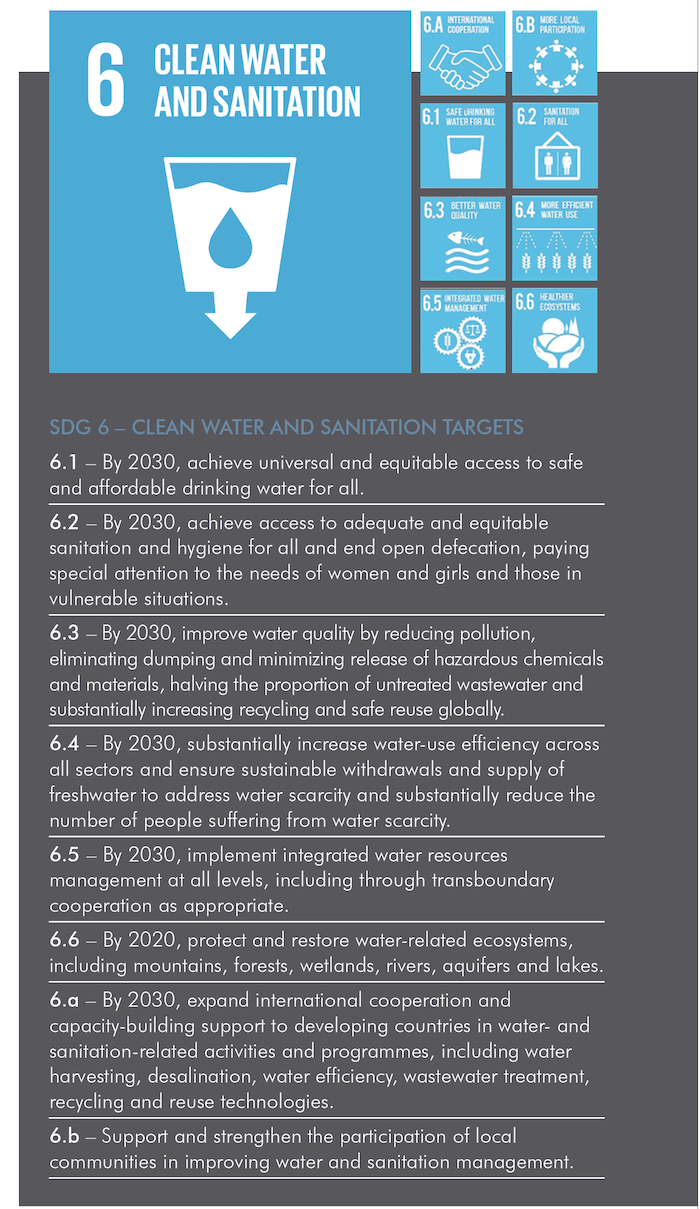Arelatively new and colorful lapel pin is becoming more common throughout Water Environment Federation (WEF; Alexandria, Virginia) events and throughout the water sector. This 25-mm (1-in.) circle is decked out with 17 multi-colored pie slices. It evokes the vision of an old Trivial Pursuit game piece on steroids and packs a lot of meaning and promise for making the world a better place by 2030.
 The circle and colors depicted on these pins represent the United Nations Sustainable Development Goals (SDGs). Water professionals contribute toward meeting nearly all SDGs, but focus their passion and dedication to preserving the environment and protecting public health most directly on SDG 6 – Clean Water and Sanitation.
The circle and colors depicted on these pins represent the United Nations Sustainable Development Goals (SDGs). Water professionals contribute toward meeting nearly all SDGs, but focus their passion and dedication to preserving the environment and protecting public health most directly on SDG 6 – Clean Water and Sanitation.
SDGs at a Glance
In 2015, the United Nations member states adopted the 2030 Development Agenda titled, Transforming Our World: the 2030 Agenda for Sustainable Development. This call-to-action for all countries was designed to work toward peace and prosperity for people and the planet. The agenda outlined 17 SDGs related to thematic areas such as water, energy, and climate; with associated targets and indicators.
SDG 6, appropriately associated with bright blue, features targets for water reuse, access, efficiency, affordability, resiliency, integrated water resources management, reduction in untreated wastewater, and enhanced research and development for water technologies. By definition, water professionals worldwide contribute to achieving SDG 6 every day, as they have been for as long as water and wastewater professionals have existed.
WEF Actions
In 2019, WEF released a position statement in support of the objectives of the SDGs and recognizing the work that our members, Member Associations, and the water sector as a whole contribute to furthering progress. The SDGs align directly with four WEF Strategic Goals:
• Catalyze Innovation,
• Enhance the Value of Water,
• Provide a Broad Range of Content, and
• Leverage Global Network of Water Professionals.
WEF will continue to foster progress toward achievement of the SDGs by increasing water sector and public awareness of the SDGs and their importance. WEF also will promote the work that water professionals are doing to further progress toward achievement of these goals. In addition, WEF is always seeking opportunities to build upon the work currently being done and to collaborate with our Member Associations and partners worldwide; this effort also supports SDG 17 – Partnership.
The SDGs represent the evolution of the Millennium Development Goals (MDGs). At the Millennium Summit in 2000, UN Leaders adopted the United Nations Millennium Declaration, committing their nations to a new global partnership to reduce extreme poverty. This declaration set out a series of time-bound targets - with a deadline of 2015 to meet the eight MDGs focused on Developing Countries. One of the critical goals was MDG Target 7.C: Halve, by 2015, the proportion of the population without sustainable access to safe drinking water and basic sanitation. The world met the target of halving the proportion of people without access to improved sources of water, five years ahead of schedule. Between 1990 and 2015, 2.6 billion people gained access to improved drinking water sources. Worldwide 2.1 billion people have gained access to improved sanitation. Despite the impressive progress, 2.4 billion are still using unimproved sanitation facilities, including 946 million people who are still practicing open defecation.
Framing the Plan
The SDGs build on the lessons learned from the MDGs. At the heart of the 17 SDGs is an urgent call for action by all countries in a global partnership. These goals recognize that ending poverty and other deprivations must go hand-in-hand with strategies that improve health and education, reduce inequality, and spur economic growth — all while tackling climate change and working to preserve our oceans and forests.
The 17 goals also encompass 169 targets that are measured by 232 indicators. For example, SDG 6 challenges the world to “ensure availability and sustainable management of water and sanitation for all.” The eight targets identified for the water sector (see sidebar on p.28) demonstrate the full breadth and scope of the work of water professionals.
Beyond SDG 6
Water professionals are the front line in public health, the circular economy and sustainable communities. It would only make sense that water also directly affects most of the other SDGs including
• SDG 2 – Zero Hunger;
• SDG 3 – Good Health and Well-Being;
• SDG 5 – Gender Equality;
• SDG 7 – Affordable and Clean Energy;
• SDG 9 – Industry, Innovation, and Infrastructure;
• SDG 11 – Sustainable Cities and Communities;
• SDG 12 – Responsible Consumption and Production;
• SDG 13 – Climate Action;
• SDG 14 – Life below Water; and
• SDG 15 – Life on the Land.
Understanding the SDGs recognizes the value, both locally and globally, that the work that water, wastewater, and stormwater professionals already do, and will continue to do. The framework enables water, wastewater, and stormwater utilities and organizations to increase legitimacy in their relations with customers and stakeholders, provides a sense of pride to operators, engineers, regulators, managers, academics, businesspeople, and all other professionals who work in the water sector and encourages using the global perspective on water resources to facilitate watershed-based solutions on a local level.
More information on all of the SDGs, including their targets and measures can be found at https://sustainabledevelopment.un.org.
Dr. Barry Liner is Chief Technical Officer at the Water Environment Federation and leads WEF’s Water Science and Engineering Center.

